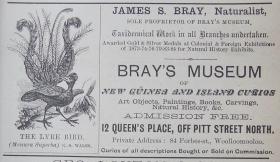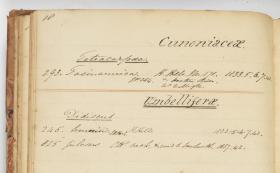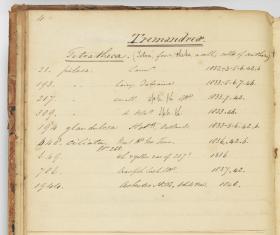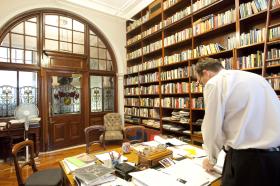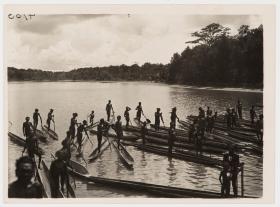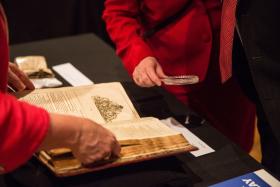Historical discoveries are usually expected to remain firmly in the past. It comes as a surprise, then, when an unanticipated find in the State Library’s extraordinary collection has direct relevance to the contemporary world, and potentially to our environmental future.
Yet this may well be the case for a battered catalogue filed among the papers of a quirky character from late-colonial Sydney, James Samuel Bray (1849–1918). An amateur naturalist, incessant correspondent and sometime bounder, in 1884 he also established a long-forgotten city landmark: Bray’s Museum of Curios.
Curios in endless variety
Bray’s currency was artefacts. Indeed, rather than a lyrebird, his museum’s emblem should have been a bower bird, given the eclectic range of his collecting. Advertisements lured customers to Bray’s Museum with the promise of ‘island curios in endless variety’, alongside human skulls, platypus furs, tortoise shells and ‘live venomous and non-venomous snakes’.
But with urban expansion erasing the traces of Sydney’s Indigenous and early settler heritage, a new antiquarian market emerged. As the colony of New South Wales approached its centenary in 1888, Bray found nostalgic buyers for old china, coins, carvings and ‘early Australian relics’, from paintings and books to convict chains.
Somewhere at the intersection of Bray’s interests as a naturalist, antiquarian, curator and shopkeeper came the records of colonial science. From age 11, when ‘Master James Bray’ donated the ‘nest and egg of a wren’ to the Australian Museum, he became close to its curator, Gerard Krefft. Following Krefft’s death in 1881, Bray came into possession of a range of his scientific effects, including handwritten articles and original artworks, several of which survive in the State Library’s collection.[i]
Nevertheless, because Bray’s own manuscripts range from a ‘living atom of creation’ to the ‘extraordinary appearance of the water in Sydney Harbour’, an undated item entitled simply ‘catalogue of Tasmanian plants’ seemed likely to be his own work.[ii] Emerging from storage, however, the catalogue was clearly not in Bray’s distinctive handwriting. Furthermore, referring to plant specimens collected in Van Diemen’s Land (as Tasmania was then known) in the 1830s, it preceded Bray’s birth by nearly two decades.
But if the catalogue was not by Bray, who then had compiled it? Was there something within it which could solve the mystery of its authorship?
Suspecting that it might prove an important artefact of early colonial botany, a collaboration began across three Australian cities to establish the authorship and value of this catalogue. Drawing upon their knowledge of colonial science, historians Peter Hobbins and Eleanor Cave worked with Lyn Cave at the Tasmanian Herbarium to establish that this fragile book was a personal record maintained by pioneer botanist, Ronald Gunn.
Botanising and corresponding
Ronald Campbell Gunn (1808–81) was one of the most prolific and productive plant collectors in Tasmania during the nineteenth century.
Arriving in Van Diemen’s Land with his young family in 1830, Gunn quickly settled into life as a public servant in the convict department. In the relatively small social circle of Launceston, Gunn became fast friends with Robert Lawrence, who had a passion for collecting native plants, and who had struck up a correspondence with William Hooker. Then working at Glasgow, Hooker was later to become director of Britain’s Royal Botanic Gardens at Kew.
Gunn devoted much of his spare time to ‘botanising’, exploring various locales all over the island, always adding to his collection of new specimens, and noting the distribution patterns of others. What sets Gunn’s work apart from others in the colony was the volume of material he collected. Furthermore, he was tireless and fastidious in his efforts to maintain this collection, to document it, and to correspond with others about it.
There are few other colonial collectors who maintained such a well-ordered collection of specimens, greatly assisted by Gunn’s training in the 1820s as a library clerk. The importance of this skill cannot be overstated – that Gunn employed a numbering and naming convention for his collection, and was consistent in using it, means that the majority of his catalogues and specimens can still be cross-referenced and used by researchers today.
Gunn’s system allowed him to number each different plant species he collected. Every item had its number and collecting details noted on a slip of paper attached to the plant, then Gunn recorded the corresponding notes in his catalogue. He would keep one example of each number, and send the duplicates to William Hooker (and later his son, Joseph) to identify. Once identified, the Hookers would mail Gunn a list of all of the identified plant names, which Gunn would transcribe against the numbers in his catalogue.
Over the many years of to-and-fro, this relationship introduced hundreds of new plants to botanical science, and provided Gunn with a rich botanical education that he then shared with friends and correspondents.
Researchers have known about several catalogues that Gunn compiled and sent to his contacts over the years, but until this discovery we have seen little evidence of catalogues that Gunn wrote and kept to accompany his personal herbarium.
Further examination of its contents promises to yield new information about the scale and size of Gunn’s collecting talents.[iii]
Until now, no complete catalogues of Gunn’s work were known to exist. This original document is particularly valuable to botanists because it contains Gunn’s notes on where and when he collected each species.
An environmental archive
Gunn presented his private herbarium to the Royal Society of Tasmania in 1878, and this donation of preserved plants today forms one of the founding collections of the Tasmanian Herbarium, a section of the Tasmanian Museum and Art Gallery.[iv]
The Tasmanian Herbarium is internationally recognized as having the most comprehensive record of Tasmanian flora in the world. Its plant specimens are the permanent material evidence of which plants occur in Tasmania, their distribution in space and time, and their variability. They are also the raw materials for further discovery and knowledge of the island’s unique flora. Even today, part of the process of identifying new species includes researching earlier botanists’ work.
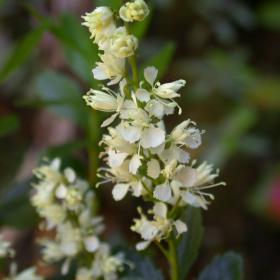
Until now, no complete catalogues of Gunn’s work were known to exist. This original document is particularly valuable to botanists because it contains Gunn’s notes on where and when he collected each species. The Herbarium holds a corresponding plant specimen matching some of the records, but there are many others in the catalogue for which a physical specimen is unknown. Gunn’s catalogue alerts us to the possible existence of plant specimens in other herbaria with which he was connected, particularly the Royal Botanic Gardens, Kew, and London’s Natural History Museum.
Gunn’s keen eye led him to discover many new species of plants. His Tetratheca (no. 1944) is amongst them. He found it in the Asbestos Hills (now Range), west of the Tamar River in the north of the state, and recognized it as different from the other Tetratheca species he had seen. Joseph Hooker named the new species Tetratheca gunnii in Gunn’s honour.[v]
Gunn’s interest in documenting natural history, at a time when the island was still largely unexplored by Europeans, means that his catalogue also has the potential to evaluate the way colonisation has altered the environment. For example, Tetracarpaea tasmannica (Gunn’s no. 293), an endemic Tasmanian shrub, grows in subalpine areas. Gunn lists several locations for it, including Mount Wellington, on Hobart’s doorstep. We know today that – presumably due to the many fires on the mountain since white settlement – it is rarely seen there.[vi]
One of the Tasmanian Herbarium’s key tasks is to maintain a census of plants – both native and naturalised – growing in the state. In effect, this is what Ronald Gunn himself so painstakingly compiled, in the middle of the nineteenth century.[vii] It is a remarkable testament to the curious collecting urges of James Bray, and the endless treasures held by the State Library of New South Wales, that Gunn’s ‘botanising’ may yet shape how we understand our environmental past, present and future.
Authors
Dr Peter Hobbins
Dr Peter Hobbins is a historian of science, technology and medicine at the University of Sydney. His 2016 Merewether Fellowship focuses on the life, work and museum of James Bray.
Dr Eleanor Cave
Dr Eleanor Cave manages the donations team at the Australian War Memorial in Canberra.
Lynette Cave
Lynette Cave is the Registration Officer for the Tasmanian Herbarium, a part of the Tasmanian Museum and Art Gallery in Hobart.
FOOTNOTES
[i] As explored by State Library curator Margot Riley in the Autumn 2016 issue of SL magazine.
[ii] James Samuel Bray papers and sketches, 1874 - 1896 in A 186, ‘Catalogue of Tasmanian plants, undated’, State Library of New South Wales.
[iii] For more information on Ronald Gunn and plant collecting in nineteenth century collecting, see Eleanor Cave, ‘Flora Tasmaniae: Tasmanian naturalists and imperial botany, 1829–1860’, Doctoral thesis, University of Tasmania, 2012.
[iv] See Tasmania Herbuim.
[v] The specimen can be seen at Kew Royal Botanical Gardens.
[vi] An example of a Tetracarpaea specimen collected by Gunn, sent to Kew Royal Botanical Gardens.
[vii] 2016 Census of The Vascular Plants of Tasmania, Including Macquarie Island.

